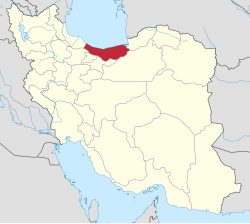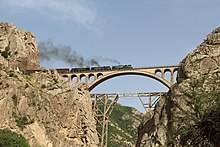Savadkuh County
Savadkuh County
Persian:شهرستان سوادكوه | |
|---|---|
 Kangelo,Savadkuh | |
 Location of Savadkuh County in Mazandaran province (bottom, yellow) | |
 Location of Mazandaran province in Iran | |
| Coordinates:36°06′N52°56′E/ 36.100°N 52.933°E[1] | |
| Country | |
| Province | Mazandaran |
| Capital | Pol-e Sefid |
| Districts | Central,Zirab |
| Area | |
| • Total | 2,078.00 km2(802.32 sq mi) |
| Population (2016)[3] | |
| • Total | 43,913 |
| • Density | 21/km2(55/sq mi) |
| Time zone | UTC+3:30(IRST) |
| Savadkuh County can be found atGEOnet Names Server,atthis link,by opening the Advanced Search box, entering "9207257" in the "Unique Feature Id" form, and clicking on "Search Database". | |
Savadkuh County(Persian:شهرستان سوادكوه)[a]is inMazandaranprovince,Iran.Its capital is the city ofPol-e Sefid.[4]
History[edit]
Darius I,the greatAchaemenidPersianmonarch in his famous inscription inBehistun,mentions Pâtišvâreš as one of the territories under his rule. ThisOld Persianform subsequently becameMiddle PersianPateŝxârgar and, following the Arab conquest, Perso-Arabic Faršavâdjar. TheGreekhistoriographerStraborecords this name as Prâxovâtrâs.
In his inscription atKa'ba-ye Zartosht,the secondSassanidPersianmonarchShapur I,refers to the region as Pâdešxâr. In theBook of Deeds of Ardashir, Son of Babag,it is Patešxâr again.Ibn Isfandiyarand MirZahir al-Din Mar'ashi– the old geographers of Mazandaran – give its name as Patešxârgar as a large area in present-day Mazandaran, includingAzerbaijan,Gilan,Tabaristan,Kumeshand Damghan.
Mohammad Hassan Khan (Etemad Saltaneh'sTadvin Fi Ahval Jebal Shervin,History of Savadkuh) mentions it as the old name of the ancient area of Savâdkuh. They believe that the word "Savad" was distorted and changed to Faršavât. Savadkuh enjoyed great importance in the history of Tabaristan and even in Iran.
Its tall mountains were the feudal seats of theBavand dynasty,with which theKaran-Vandswere allied. They defended the area against the invasions of the Amawid andAbbasidsand tried to preserve theirZoroastrianreligion and culture. The existence of numerous fortresses and military fortifications that date to the 8th–10th centuries vindicate this claim. In addition, Lajim tower with its 10th century brick-face inscription inPahlavi scriptdemonstrates the attention of the Savâdkuhs to the script, language and customs of their ancestors. The population of this region composed many poems, describing the heroic efforts and bravery of their notables.
Administrative changes[edit]
After the 2011 National Census, Shirgah District was separated from the county in the establishment ofNorth Savadkuh County,which was divided into two districts of two rural districts each, withShirgahas its capital and only city.[5]KaseliyanandSorkhkolaRural Districts, and the city ofZirab,were separated from theCentral Districtin the formation ofZirab District.[6]
Demographics[edit]
Language[edit]
The languages spoken in Savadkuh areMazandaraniandPersian,for the major part; and Mazandarani and Persian for the inhabitants of the villages. Its native inhabitants are Shiite Muslims.
Population[edit]
At the time of the 2006 census, the county's population was 66,430 in 17,918 households.[7]The following census in 2011 counted 64,378 people in 19,506 households.[8]The 2016 census measured the population of the county as 43,913 in 14,956 households.[3]
Administrative divisions[edit]
Savadkuh County's population history and administrative structure over three consecutive censuses are shown in the following table.
| Administrative Divisions | 2006[7] | 2011[8] | 2016[3] |
|---|---|---|---|
| Central District | 42,679 | 40,969 | 22,537 |
| Kaseliyan RD | 3,872 | 4,064 | |
| Rastupey RD | 7,084 | 7,557 | 7,529 |
| Sorkhkola RD | 520 | 552 | |
| Valupey RD | 3,538 | 4,535 | 5,521 |
| Alasht(city) | 976 | 874 | 1,193 |
| Pol-e Sefid(city) | 8,473 | 7,708 | 8,294 |
| Zirab (city) | 18,216 | 15,679 | |
| Shirgah District[b] | 23,751 | 23,409 | |
| Lafur RD | 4,826 | 4,493 | |
| Sharq va Gharb-e Shirgah RD | 10,396 | 10,787 | |
| Shirgah(city) | 8,529 | 8,129 | |
| Zirab District | 21,376 | ||
| Kaseliyan RD | 4,217 | ||
| Sorkhkola RD | 968 | ||
| Zirab(city) | 16,191 | ||
| Total | 66,430 | 64,378 | 43,913 |
| RD = Rural District | |||
Geography[edit]

Covering an area of 2,441 square kilometres (942 sq mi), Savadkuh is at the centre of Mazandaran Province. It is limited northwestward byNorth Savadkuh County,westward byBabol County,eastward bySari County,southward by theAlborzmountain range andTehran province,and southeast bySemnan province.The main part of this county is located in a valley, in the centralAlborz region,where the Tâlâr river passes through it. There are 250 seasonal and permanent villages.[citation needed]
The tallest summit of Savadkuh, is Khero-Naru, with a height of 3,620 metres (11,880 ft). The most important rivers flowing in this city are Tâlâr and Babol-rud, which originate from the Alborz mountain range standing southeast and southwest of Savadkuh. These rivers irrigate the farmlands in Babol, Babolsar and Qaemŝahr. Including two areas of mountain in the north and foothill in the south, the mountainous area has a temperate and humid climate, and the weather in the south is dry and cold.[citation needed]
Economy[edit]
The farmlands in Savadkuh are limited because of its large forests and mountainous areas. So the farmers use their crops themselves, including rice, wheat, barley and sugar cane. According to geographical features, the economy of this city is based on apiculture and animal husbandry, more than agriculture.[citation needed]
Natural attractions[edit]
The most important natural attractions of Savadkuh are: Ŝur Mast lake, near a village by the same name, Gazu waterfall in Lafur hamlet, waterfalls of Shirga and Gaduk, the mountains of Arfa Kuh, Sangar and Qadamgah, in Rassto Pei hamlet and Shervin mountain in Valu Pei hamlet; and Alasht city.[citation needed]
Historical sites and landmarks[edit]


Veresk Bridge[edit]
TheVeresk Bridgeis amasonryarchbridge in northernIran.It was constructed mostly by Austrians beforeWorld War IIby leadership of an engineer named Walter Aigner, constructed during the reign ofReza Shah.[9]It is located in theVeresk districtof Savadkuh County, inMazandaranprovince.[10][11]
During World War II, it was known as the Pol-e Piroozi ( "The bridge of victory" ).[12]The bridge stands 110 metres (360 ft) tall and its arch measures 66 metres (217 ft) long. The bridge serves theTrans-Iranian Railwaynetwork in Northern Iran. The Veresk bridge connects the railway between Tehran and theCaspian Searegion. It is located inMazandaranVeresk district of Savadkuh, 85 kilometers south ofGhaemshahrand connects two of the mountains in the Abbas Abad region. The bridge is one of the masterpieces of the Danish engineering firmKampsax,(consisting of Danish, German and Austrian engineers) serving theTrans-Iranian Railwaynetwork in Northern Iran.[13]The construction of this bridge included craftsmen of many nationalities, including many Italian. The Master Carpenter for the construction of the lumber concrete forms was Giacomo Di Marco, from the Friuli region of Italy, and detailed in the book he authored. It has been said after finishing the bridge, people had a fear that the train wouldn't be able to pass the narrow bridge and that it would break. As a result, the engineer and his family stood under it when the first train passed the bridge (local accounts claim that Reza Shah had asked them to do so anyway).[14]
Lajim Tower[edit]
Lajim Tower, also known as Tomb Tower of Lajim,[15]is a tall cylindrical tower in the village ofLajim[16]in the province ofMazandaran,Iran. The tower was built around AD 1022.[15]The Lajim inscriptions includes the first documented example of the wordqubbareferring to the domed structure of the building.[16]There is no doubt that the Lajim Tower was themausoleumof an unknownPersianprince ofTabaristan.[16]
Kangelo Castle[edit]
Kangelo Castle is a historical fortress located in the Savadkuh and in the village ofKangelo.TheKangelo Castleduring the time TheSassanian Empirewas built. According to historians, the castle of Kangelo was used as a place to worship the mirta.
Espahbod Khorshid Cave[edit]
This cave is located between the railway station of Pol-e Sefid and Surkh Abad, in the vicinity of Do Ab. It was discovered in the year 1956. The cave has a simple area or hall, with a ceiling 80 m. in width and height, and is considered spectacular in the world. Near this cave is a remnant of a ruined castle and tower, which was once a beautiful structure of stone and mortar. This cave is also known as Dej-e-Afsanehie, and this was most probably the defense center of theHouse of IspahbudhanofMazandaranin the past.
Balu Bridge[edit]
Located along the Shirgah-Zirab road, near Talar river, it was made of fired bricks and mortar. The main part of this bridge was destroyed because of breaking, and now two herring-bone-shaped arches remained intact. One of them is 3 metres (9.8 ft) wide and 4.75 metres (15.6 ft) high, and another is 4.5 metres (15 ft) wide and 5.50 metres (18.0 ft) high. According to its architectural features, it probably dates back to before theSafavid dynasty.
Urim Rudbar Church[edit]
This monument was built, following the erection of the northern Iranian railway. It was used for religious ceremonies by foreign personnel. The church consists of a chamber, measuring 4.20 by 5.20 metres (13.8 by 17.1 ft). With a height of 4 metres (13 ft), it houses aprayer nicheand four cement candlesticks. The construction was made of stone and cement.
Notable people[edit]
Savadkuh is the birthplace ofReza Shah Pahlavi,the founder of thePahlavi dynasty,andHabibollah Badiee,a noted musician.[17]
See also[edit]
![]() Media related toSavadkuh Countyat Wikimedia Commons
Media related toSavadkuh Countyat Wikimedia Commons
Notes[edit]
- ^AlsoromanizedasŜahrestāne Sawādkuh,Savadkooh,andSavadkouh
- ^Transferred toNorth Savadkuh County[5]
References[edit]
- ^OpenStreetMap contributors (30 May 2023)."Savadkuh County"(Map).OpenStreetMap(in Persian).Retrieved30 May2023.
- ^Management and Planning Organization of Mazandaran, 2006
- ^abc"Census of the Islamic Republic of Iran, 1395 (2016)".AMAR(in Persian). The Statistical Center of Iran. p. 02. Archived fromthe original(Excel)on 7 October 2021.Retrieved19 December2022.
- ^Habibi, Hassan (21 June 1369)."Approval of the organization and chain of citizenship of the elements and units of the divisions of Mazandaran province, centered in Sari city".Lamtakam(in Persian). Ministry of Interior, Defense Political Commission of the Government Council. Archived fromthe originalon 14 January 2024.Retrieved14 January2024.
- ^abRahimi, Mohammadreza (20 April 2012)."With the approval of the Cabinet, Northern Savadkuh County was created".DOLAT(in Persian). Ministry of Interior, Board of Ministers. Archived fromthe originalon 26 December 2016.Retrieved26 May2023.
- ^Rahimi, Mohammad Reza (4 May 2011)."Divisional reforms in Mazandaran province".Laws and Regulations Portal of the Islamic Republic of Iran(in Persian). Ministry of Interior, Defense Political Commission of the Government Board. Archived fromthe originalon 22 May 2023.Retrieved22 May2023.
- ^ab"Census of the Islamic Republic of Iran, 1385 (2006)".AMAR(in Persian). The Statistical Center of Iran. p. 02. Archived fromthe original(Excel)on 20 September 2011.Retrieved25 September2022.
- ^ab"Census of the Islamic Republic of Iran, 1390 (2011)".Syracuse University(in Persian). The Statistical Center of Iran. p. 02. Archived fromthe original(Excel)on 19 January 2023.Retrieved19 December2022.
- ^Veresk Bridge, the Born of the World War
- ^Veresk Bridge / SeeIran
- ^Veresk bridge in Mazandaran / Mehr News Agency
- ^Veresk Bridge / itto
- ^Fritz Leonhardt: Brücken. Deutsche Verlags-Anstalt, Stuttgart 1982,ISBN3-421-02590-8;Marcel Prade: Les grands ponts du monde. Deuxième partie, Hors d'Europe. Brissaud à Poitiers,ISBN2-902170-68-8
- ^Veresk Bridge Safeauf FinancialTribune
- ^abMichailidis, Melanie (2003)."Tomb Tower of Lajim".Aga Khan Visual Archive.
- ^abcBlair, Sheila (1992).The Monumental Inscriptions from Early Islamic Iran and Transoxiana.pp. 88–90.
- ^"آواهای کمشنیده از دیروز تا امروز • حبیب الله بدیعی – DW – ۱۳۹۶/۱۱/۱۹"[Rarely heard sounds from yesterday to today: Habibullah Badii].Deutsche WellePersian(in Persian).Retrieved9 July2024.
